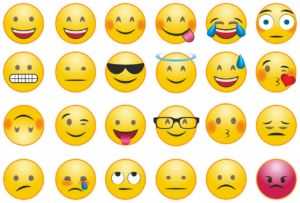Despite their reputation as complicated and often inconvenient, emotions are as common, and as essential, to the human experience as breathing. But what are they? Despite psychologists’ many attempts, developing a clear and comprehensive definition of emotion has proved challenging. Dr. Marsha Linehan, the founder and developer of DBT, describes emotions as “brief, involuntary, full-system, patterned responses to internal and external stimuli.” That’s pretty technical, so let’s break it down.
 Brief: It might surprise you to learn that most emotions last only a few seconds to a few minutes. It is common to experience emotions as lasting longer. This occurs when either our thoughts or events in our environment reactivate or intensify our emotional experience.
Brief: It might surprise you to learn that most emotions last only a few seconds to a few minutes. It is common to experience emotions as lasting longer. This occurs when either our thoughts or events in our environment reactivate or intensify our emotional experience.
Involuntary: Emotions are automatic and cannot be changed directly. We cannot simply tell ourselves to be happy or sad. We have to change the environment, our thoughts, or our behaviors if we want to change our emotions.
Full-system: Emotions are not just in our brain. They occupy our entire body–from sweaty palms to heart rate to that sinking feeling in your stomach. They are complex responses which influence our thoughts, behaviors, urges, and physiological reactions.
 Responses to internal and external stimuli: Emotions are triggered by prompting events. These might be external events such as a breathtaking sunset or a gut-wrenching break-up. Prompting events may also arise internally, such as how you react when you imagine your first kiss. Sometimes, emotions can be responses to other emotions. For instance, perhaps you have regretted saying words in anger which you did not mean and later felt guilty about your actions.
Responses to internal and external stimuli: Emotions are triggered by prompting events. These might be external events such as a breathtaking sunset or a gut-wrenching break-up. Prompting events may also arise internally, such as how you react when you imagine your first kiss. Sometimes, emotions can be responses to other emotions. For instance, perhaps you have regretted saying words in anger which you did not mean and later felt guilty about your actions.
Have you ever thought it would be better to just not have emotions? They can be extremely painful and hard to change. If so, you are one of many.
If emotions can be so painful and inconvenient, why do we have them? What’s the point? Are we suffering needlessly?
No. Emotions are essential to keep us safe and communicate with others. Our bodies have developed a highly specialized “ïnformation superhighway” to help us survive. Internally, emotions send us messages to help us avoid danger and get what we need. For example, you may hear a loud noise, experience fear, and flee from an impending threat. Your fear heightens your senses, giving you a super spidey-sense and urging you to either eliminate the threat or run for cover.
 Emotions communicate with others as well. Our brains are highly attuned to facial expressions, body language, and nonverbal communication. Being attuned to people around us does not allow us to read their minds. However, it gives us important information about how to respond to them. If someone is angry, it may not be a good time to give them constructive criticism or ask them for a favor. Noticing someone is sad or scared might move us to comfort or help them. Giving an impassioned political speech is far more likely to rouse support from voters in comparison to a cold, rational review of the facts. Emotions move us, they connect us, and they influence others.
Emotions communicate with others as well. Our brains are highly attuned to facial expressions, body language, and nonverbal communication. Being attuned to people around us does not allow us to read their minds. However, it gives us important information about how to respond to them. If someone is angry, it may not be a good time to give them constructive criticism or ask them for a favor. Noticing someone is sad or scared might move us to comfort or help them. Giving an impassioned political speech is far more likely to rouse support from voters in comparison to a cold, rational review of the facts. Emotions move us, they connect us, and they influence others.
You know what else is really cool about emotions? They each have their own unique message. For instance, anger, which alerts us to threats, motivates us to attack, protect, and fight. Guilt, which tells us our actions are out of sync with our values, drives us to repair harm and ask for forgiveness. Sadness, which illuminates important losses, allows us to mourn and signals to others that we need comfort.
So, have I convinced you yet that we need our emotions? Developing an understanding of emotions and their purpose can help improve our relationship with ourselves and others. As we learn more about emotions and how to care for them, we become more attuned, allowing us to achieve balance and build the life we want.

